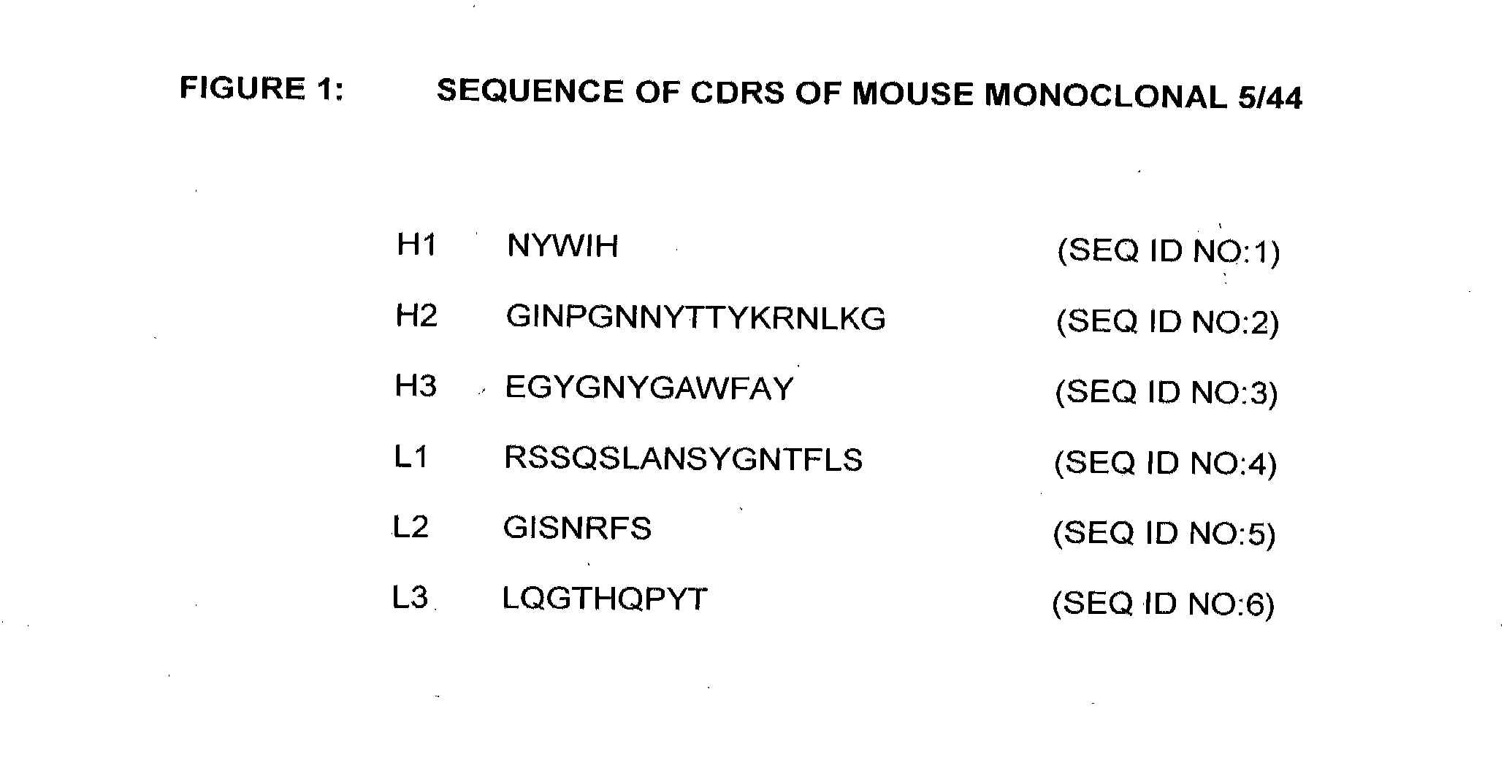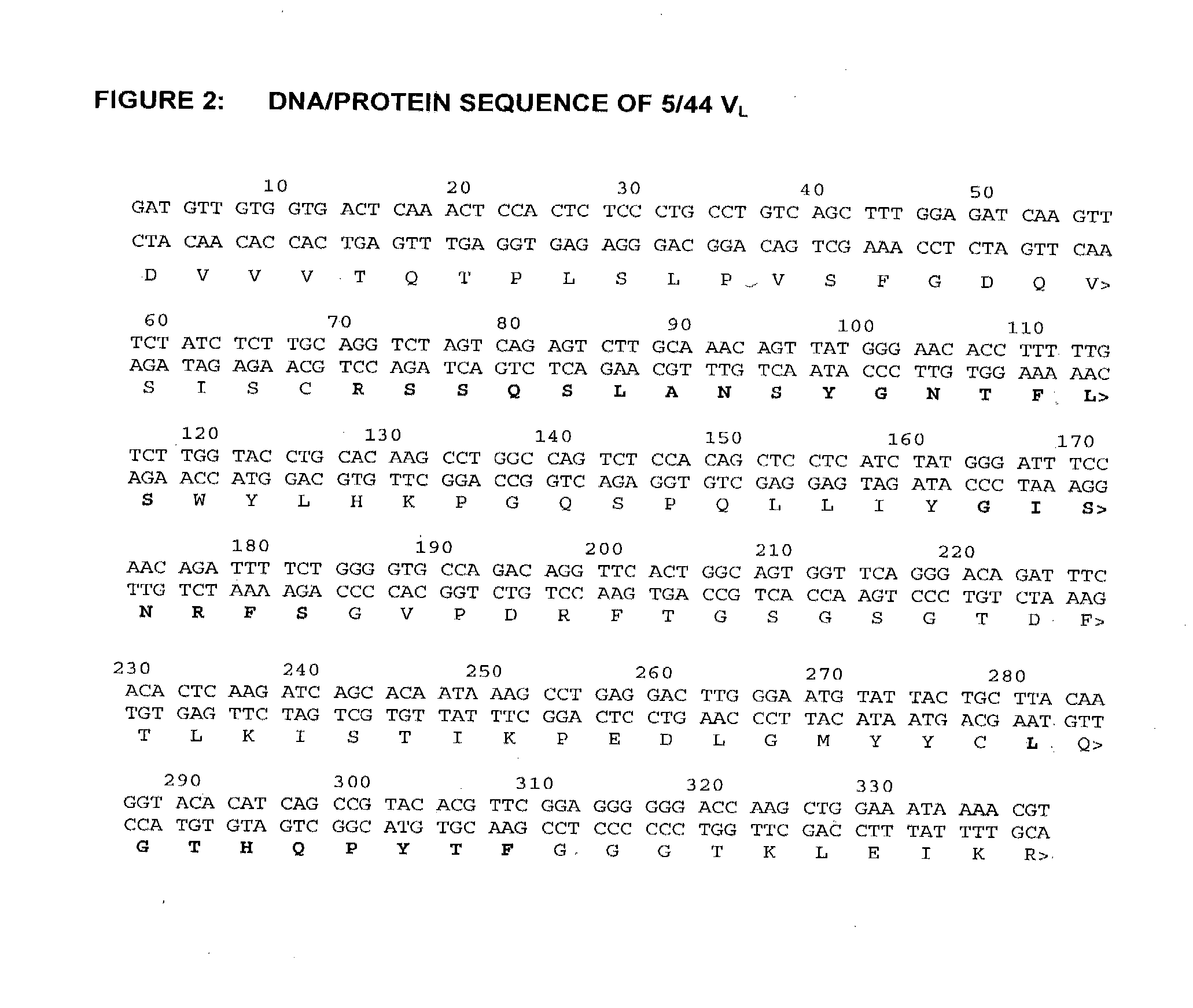Calicheamicin derivative-carrier conjugates
a technology of calicheamicin and derivatives, applied in the field of monomeric cytotoxic drugs/carrier conjugates, can solve the problems of difficult scaling up process of production the formation of protein aggregates, and the use of monomeric calicheamicin derivatives/carrier conjugates in developing therapies
- Summary
- Abstract
- Description
- Claims
- Application Information
AI Technical Summary
Benefits of technology
Problems solved by technology
Method used
Image
Examples
example 1
Generation of Candidate Antibodies
[0222]A panel of antibodies against CD22 were selected from hybridomas using the following selection criteria: binding to Daudi cells, internalization on Daudi cells, binding to peripheral blood mononuclear cells (PBMC), internalization on PBMC, affinity (greater than 10−9 M), mouse γ1 and production rate. 5 / 44 was selected as the preferred antibody.
I. Gene Cloning and Expression of a Chimeric 5 / 44 Antibody Molecule
[0223]a) Preparation of 5 / 44 Hybridoma Cells and RNA Preparation Therefrom
[0224]Hybridoma 5 / 44 was generated by conventional hybridoma technology following immunization of mice with human CD22 protein. RNA was prepared from 5 / 44 hybridoma cells using a RNEasy kit (Qiagen, Crawley, UK; Catalogue No. 74106). The RNA obtained was reverse transcribed to cDNA, as described below.
[0225]b) Distribution of CD22 on NHL Tumors
[0226]An immunohistochemistry study was undertaken to examine the incidence and distribution of staining using the 5 / 44 anti...
example 2
CDR-Grafting of 5 / 44
[0257]The molecular cloning of genes for the variable regions of the heavy and light chains of the 5 / 44 antibody and their use to produce chimeric (mouse / human) 5 / 44 antibodies has been described above. The nucleotide and amino acid sequences of the mouse 5 / 44 VL and VH domains are shown in FIGS. 2 and 3 (SEQ ID NOS:7 and 8), respectively. This example describes the CDR-grafting of the 5 / 44 antibody onto human frameworks to reduce potential immunogenicity in humans, according to the method of Adair et al., (PCT Publication No. WO 91 / 09967).
I. CDR-Grafting of 5 / 44 Light Chain
[0258]Protein sequence alignment with consensus sequences from human sub-group I kappa light chain V region indicated 64% sequence identity. Consequently, for constructing the CDR-grafted light chain, the acceptor framework regions chosen corresponded to those of the human VK sub-group I germline O12,DPK9 sequence. The framework 4 acceptor sequence was derived from the human J-region germline ...
example 3
Conjugation of NAc-Gamma Calicheamicin DMH AcBut to Humanized Anti-CD22 Antibody (G5 / 44)
[0268]In a typical conjugation reaction, humanized anti-CD22 antibody (G5 / 44) was conjugated to NAc-gamma calicheamicin DMH AcBut OSu (calicheamicin derivative) (see FIG. 17), where the target protein concentration was 7.5 mg / ml and the target calicheamicin derivative loading was 8.5 percent by weight of the protein. The target reaction pH was 8.5±0.2, and the target concentrations of the other reaction components were as follows: 50 mM N-(2-Hydroxyethyl)piperazine-N′-(4-butanesulfonic acid) (HEPBS), 37.5 mM sodium decanoate, and 9% v / v total ethanol. The reaction was conducted at 33±2° C. for one hour. Results of the analysis of this typical reaction prior to purification were as follows: Protein: 7.34 mg / ml; Calicheamicin Loading: 82.7 μg / mg; Aggregate: 93.25%; and Unconjugated Protein (LCF): 1.07% (UV Area % by HPLC).
[0269]Effect of various surfactant additives and their concentrations on prod...
PUM
| Property | Measurement | Unit |
|---|---|---|
| concentration | aaaaa | aaaaa |
| shelf-temperature | aaaaa | aaaaa |
| temperature | aaaaa | aaaaa |
Abstract
Description
Claims
Application Information
 Login to View More
Login to View More - R&D
- Intellectual Property
- Life Sciences
- Materials
- Tech Scout
- Unparalleled Data Quality
- Higher Quality Content
- 60% Fewer Hallucinations
Browse by: Latest US Patents, China's latest patents, Technical Efficacy Thesaurus, Application Domain, Technology Topic, Popular Technical Reports.
© 2025 PatSnap. All rights reserved.Legal|Privacy policy|Modern Slavery Act Transparency Statement|Sitemap|About US| Contact US: help@patsnap.com



